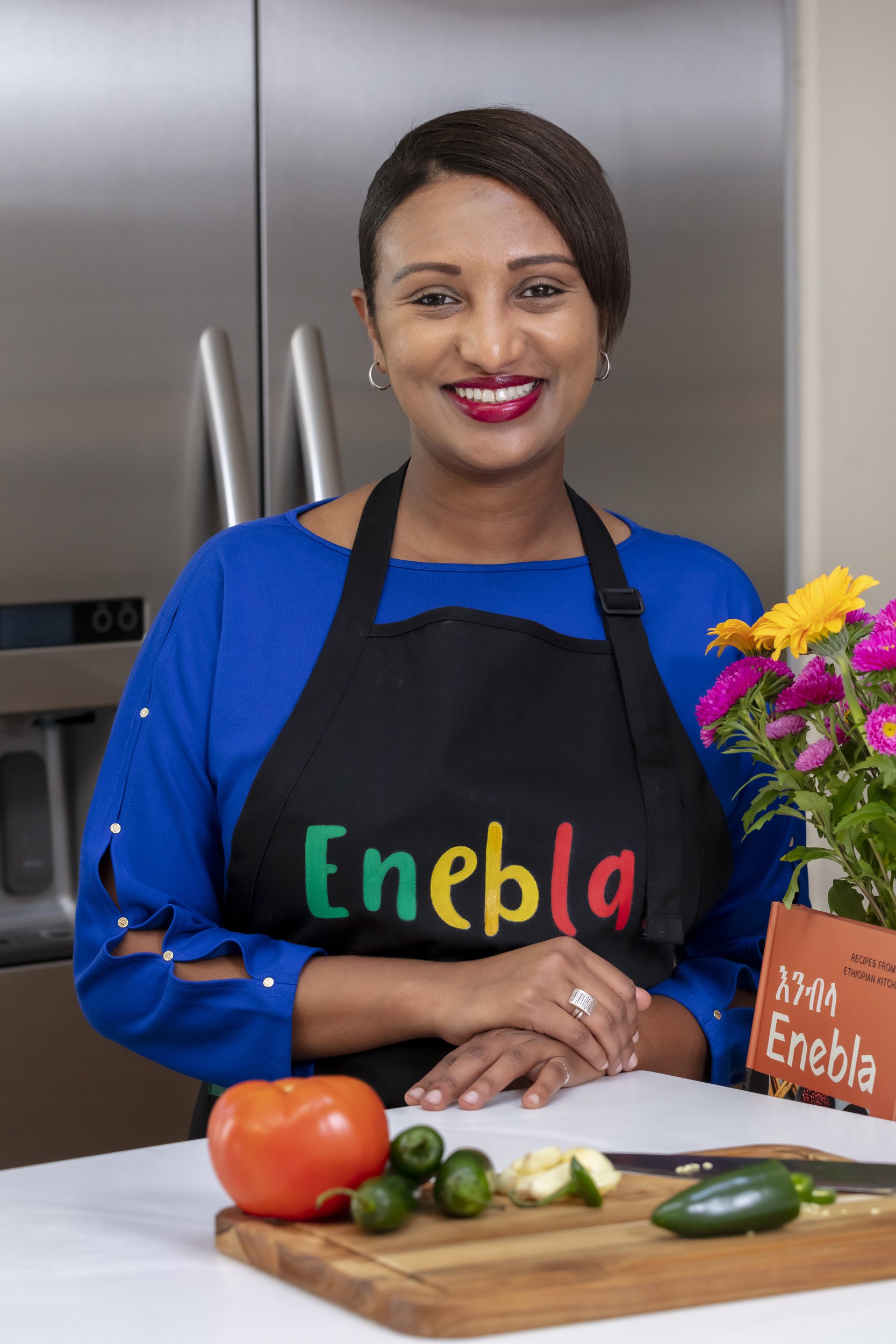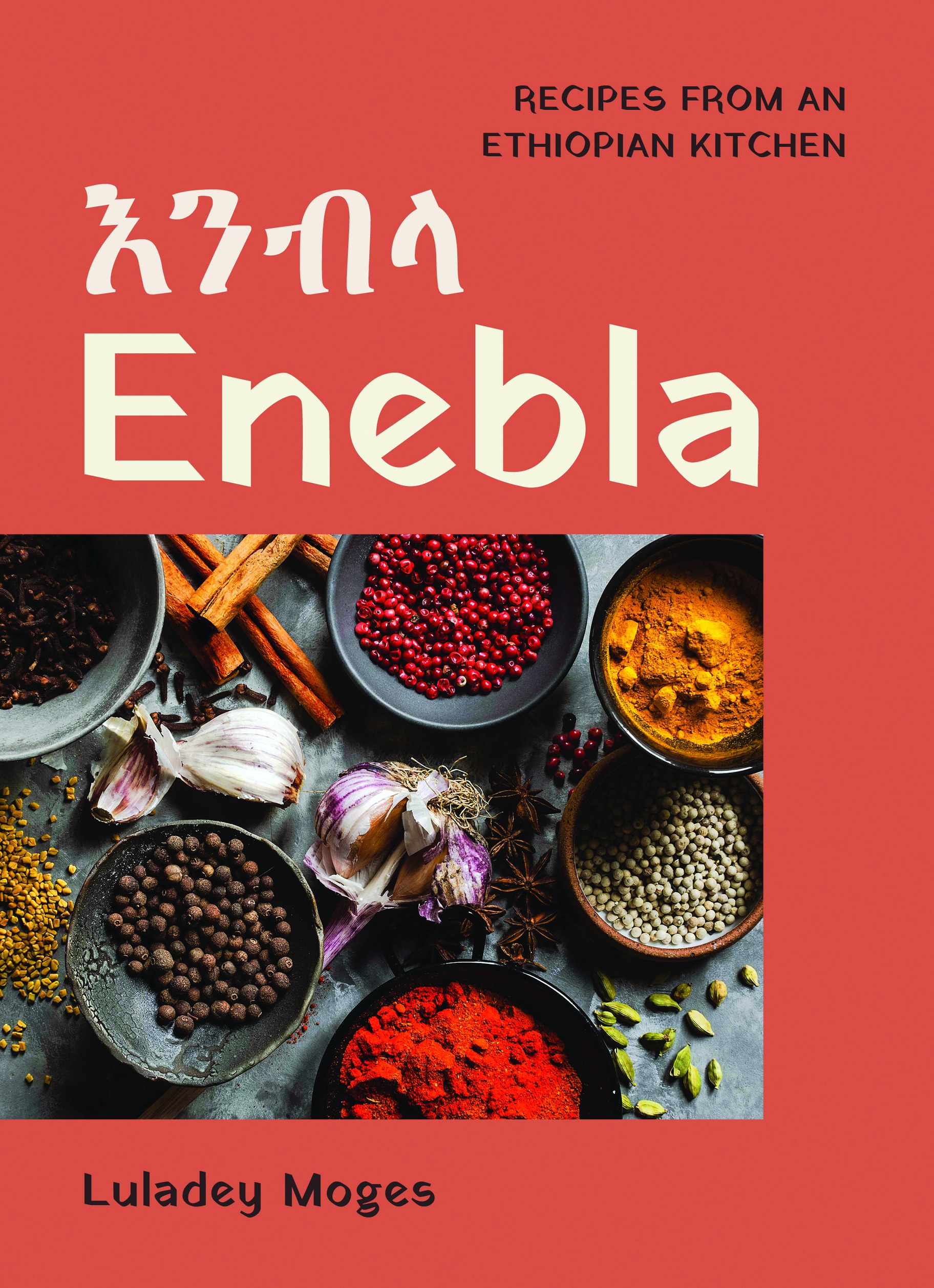Growing up, Luladey Moges’ parents were fond of saying, “We might live in America, but once you come home, this is Ethiopia.” Born in the Ethiopian capital of Addis Ababa and raised in the United States from the age of 12, Moges learned to cook from the women in her family — authentic injera, the aromatic stews called wats, and all sorts of fabulous veggie dishes.
As an adult, she became an avid home cook, but life gets busy for a mom working in the hospitality industry. So Moges revamped many of her favorite Ethiopian recipes so that each one can be cooked in under an hour. She's now compiled them in her new cookbook “Enebla: Recipes from an Ethiopian Kitchen,” named for the Amharic phrase for “let's eat.”
KCRW: Talk about the interplay of Ethiopian and Western dishes that were part of your mom and auntie's repertoires.
Luladey Moges: We do have a huge Western influence, specifically the Italian influence. Historically, the Italians wanted to conquer Ethiopia … and our Emperor fought them off. Once they lost, a lot of the soldiers decided to stay. And because of that, there's a huge integration of Italian cuisines, like the pastas, lasagna, and so forth, in our dishes and everyday repertoire. And especially all our desserts have tended to be Italian.
Also, the fact that both my parents and my aunts did travel to Europe and the US prior to us moving to the US, so they always brought back some recipes and dishes that would be integrated into our daily meals and specifically when we had events. So it would be like the Ethiopian dishes and then the Western dishes.
What do you consider to be the essential move or basic technique for making most of the food in your book?
For me, it would be just having the staples — always have onions, garlic, we do use jalapeno peppers, serrano if you like it to be even spicier. … The one staple thing that we tend to use over and over again is the berbere spice. So if you're going to start making any of these dishes, that's going to be one investment that you should definitely make, because it will be used and replicated in a lot of the dishes. As an alternative, because there are some people who don't like spice … we substitute it with turmeric. Just a regular turmeric that you can get at the grocery store would make the milder version of each dish.

Luladey Moges suggests having berbere, a blend of over 20 spices, on hand for Ethiopian cooking and administers what she calls the “Taco Bell Test” to gauge a guest’s reaction to spicy food. Photo by Bob Hodson Photography.
Tell us about the spice blend berbere. What’s in it?
I always tell people, don't try to make it yourself, only because each household has their own different recipes. It's a blend of between 24 to 28 spices. It has a mixture of cumin, star anise, actual chilies that are dried up and ground. And then just a lot of other spices that honestly I haven't made personally. I'm better at purchasing it. That's why I always recommend people just buy it. And I'm sure one day I'll perfect it, but right now I don't.
What is the recipe we should all start with and is easy to add to our weeknight dinner rotation?
The lentil dish is definitely a favorite and a go-to. It's the called the misir wat. If you are more of a meat person, then I definitely recommend the tibs, which is a beef stir fry. It's also another very quick dish to just sautee with some onions, garlic, and vegetable or olive oil to your preference.
A lot of these dishes are supposed to be made the way you'd like them. So they will be saying like, “add four jalapenos,” and if you're spice sensitive, you can always use less. Or people who love spice, like myself, instead of jalapenos, I use serranos. So those are kind of the two staple dishes.
If it's kinda … unfamiliar to start with those, then I would go with the gomen, which is essentially Ethiopian collard greens. You can have them just plain, the way they are, or you can also do them with beef.

Enebla, taken from the Amharic for “Let’s eat!” brings Ethiopian dishes to the home kitchen in under an hour. Photo courtesy of TouchWood Editions.
What's a good introductory wat to try to make?
I would probably go with the sega wat, which is the spicy beef stew, just because it's very easy to start with, and not very complicated. It asks for very minimal ingredients. You're just basically getting some beef, some onions, garlic, ginger, and then, of course, the berbere that goes in everything, and water. And then once you've sauteed everything, you just kind of let it simmer down. But also again, if it asks for three tablespoons of berbere and you're kind of sensitive to that, you're more than welcome to use less. Or if you're just like, nope, I want it completely mild, then you can also substitute with like one tablespoon of tumeric.
What's your favorite LA or Southern California store for Ethiopian ingredients and injera?
I would have to say Betty Market, which is on Centinela. They make the best injera. And also for me, which is very important, is injera’s gluten free, and it's made with only teff. It's a very specific type of flour. And it's gluten free. There are some locations that tend to do half and half, like teff and flour, and I just don't enjoy that as much. And so Betty Market in Inglewood, it's the one that you can always go and it’s guaranteed to only make itwith teff.
As far as all the other ingredients, yes, they also definitely sell it there. If not, on Fairfax in Little Ethiopia, you can go to Merkato, which has essentially everything that you need, every spice, including raw coffee, if you want to try the coffee ceremony at home. They also sell the coffee pot and cups and everything else, so it has a lot more options if you're trying to really dive in and get a lot of Ethiopian stuff.
Gomen Wot (Collard Greens Stew)
Serves 4–6
This wholesome stew is my go-to when I’m craving some greens in my diet. It’s not too spicy and it’s meat free. It’s also a versatile dish that you can have over rice as a simple lunch or use to accompany something hot and spicy if you’re entertaining.
Ingredients
- 1 pound collard greens, rinsed and roughly chopped
- 1 medium yellow onion, diced
- 1/2 cup oil
- 2 teaspoons grated ginger
- 3 cloves garlic, diced
- 1 cup water
- 3 jalapeños, deseeded and thinly sliced (or 1 green bell pepper, diced)
- Salt
Instructions
- Place the collard greens in a medium pot and add enough water to cover them by 3 inches. Bring to a boil over medium heat. Cover and cook, keeping them at a boil, until tender, 15–20 minutes. Remove from the heat, drain, and set aside.
- Meanwhile, place the onions and oil in a separate medium pot. Cook over medium heat until they are translucent and beginning to brown, about 5 minutes. Add the ginger and garlic, stir, and cook for 2 minutes. Next, add the greens and 1 cup of water and cook, stirring occasionally, on medium heat until the water has evaporated and the greens are cooked, 10–12 minutes.
- Stir in the jalapeños. Turn down the heat to low, add salt to taste, and stir. Cover and let cook, stirring occasionally, until the liquid is reduced and the peppers are soft, 5–10 minutes.
- Serve with injera, rice, or your favorite whole grain bread.
*Note: The meat version of this is called gomen besega (collard greens with beef stew). Place 2 pounds of chuck roast beef (or your favorite lean beef), cut in 1- to 2-inch cubes, in a medium pot and add enough water to cover the ingredients by 2 inches. Bring to a boil over medium heat and cook, stirring occasionally, until the beef is rare to medium-rare but not fully cooked. Remove from the heat, drain, and set aside. Follow the same recipe above, adding the meat when you add the collard greens in paragraph 2.
